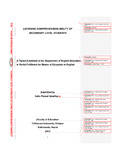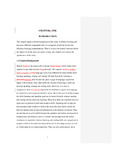Please use this identifier to cite or link to this item:
https://elibrary.tucl.edu.np/handle/123456789/1895| Title: | Listening Comprehension Ability of Secondary Level Students |
| Authors: | Upadhya, Indra Prasad |
| Keywords: | Listening Ability;Comprehension Ability |
| Issue Date: | 2012 |
| Publisher: | Faculty of English Education |
| Abstract: | This research study entitled "Listening Comprehension Ability of Secondary Level Students”' attempts to find out listening comprehension ability of secondary level students in Jhapa district and suggest some pedagogical implications. In order to collect the data the primary and secondary sources were used. One hundred students studying in ten different secondary and higher secondary schools of Jhapa district were involved for listening test. The main tools for data collection were test items based on unseen text. The test consisted of 5 five multiple choice questions and 5 five true-false questions. one mark was assigned for each correct answer. The scores obtained by the students were tabulated on the basis of the variable specified. Their level of comprehension ability was determined by using simple statistical tools: averagemean, median, mode and percentage. 14 test-takers were found to obtain 9-10 marks, 64 got from 6-8 marks, 18 test takers obtained 4-5 marks and 4 were poor listeners. 34% testees were found to obtain 8-10 marks which is distinction division according to the national standard of S.L.C. examination 44% secured the first division marks, 11% obtained the second vision marks, 7 % secured only the pass division whereas 4% were poor listeners since they could not obtained pass marks. This thesis consists of four chapters. Chapter one encompasses general background, which gives a brief definition of language. It discusses four language skills. It also describes importance of listening skill in language acquisition. Likewise, it focuses on components of listening skills, listening comprehension, problems of listening comprehension. In the same way, this chapter addresses various issues in the field of teaching and testing listening. It also explains what facility value and discrimination index refer to. Then it reviews related literature which gives critical analysis of previous research works. After that objectives are listed. My study includes 3 objectives such as: (i) to find out listening comprehension ability of the secondary level students, (ii) to find vii Formatted: Centered 12 out difficulty level and discrimination index of the test items and to suggest some pedagogical recommendations. Then the significance of my study is described. Chapter two discusses the methodology which incorporates sources of data. I used both the primary and secondary sources for my study. The primary sources consisted of 100 secondary level students studying in different government schools of Jhapa. The secondary sources were used to broaden my theoretical knowledge to carry out the research. I selected ten community based schools purposively. Ten students from each schools were selected for listening test. Test items were used as tools for data collection. Chapter three is analysis and interpretation where the quantitative approach has been used. Finally, chapter four presents findings and recommendations for pedagogical implications. objectives significance and review of the related literature. Chapter two discusses the methodology which incorporates sources of data, tools, process of data collection and limitation of the study. Chapter three illustrates analysis and interpretation of the data. In this section quantitative approach has been used. Finally, chapter four deals with findings and its recommendations for pedagogical implications. |
| URI: | http://elibrary.tucl.edu.np/handle/123456789/1895 |
| Appears in Collections: | English Language Education |
Files in This Item:
| File | Description | Size | Format | |
|---|---|---|---|---|
| cover.pdf | 55.58 kB | Adobe PDF |  View/Open | |
| Chapter.pdf | 245.9 kB | Adobe PDF |  View/Open |
Items in DSpace are protected by copyright, with all rights reserved, unless otherwise indicated.
